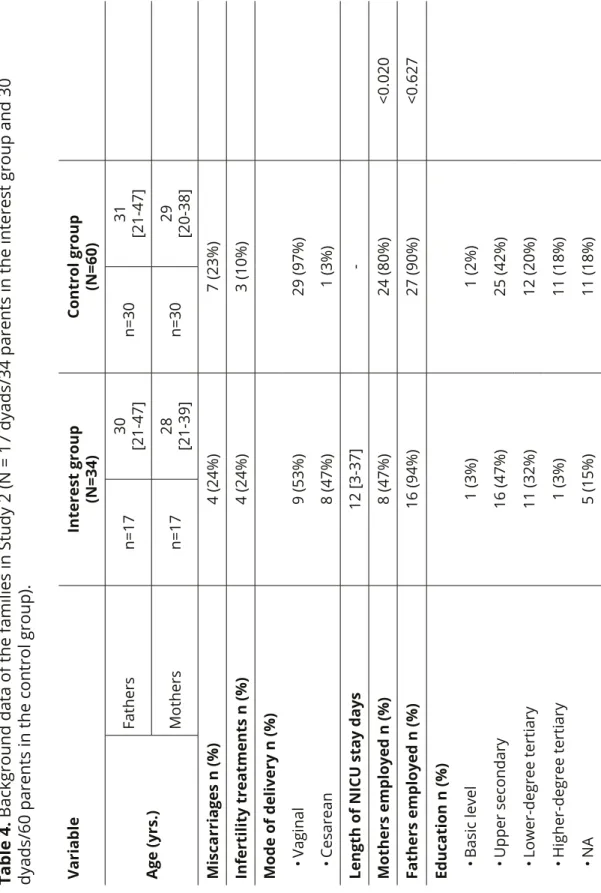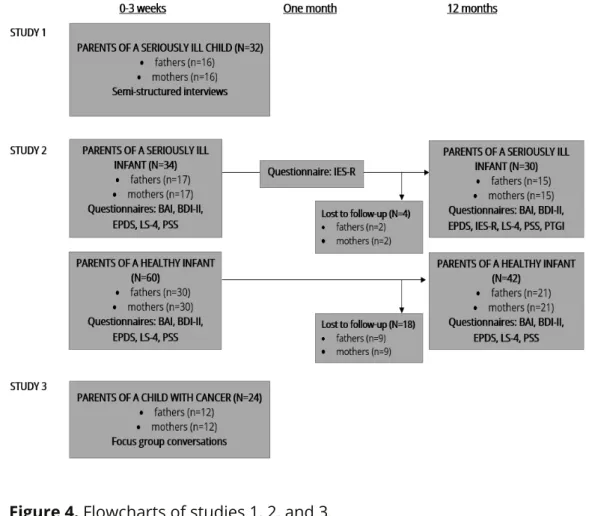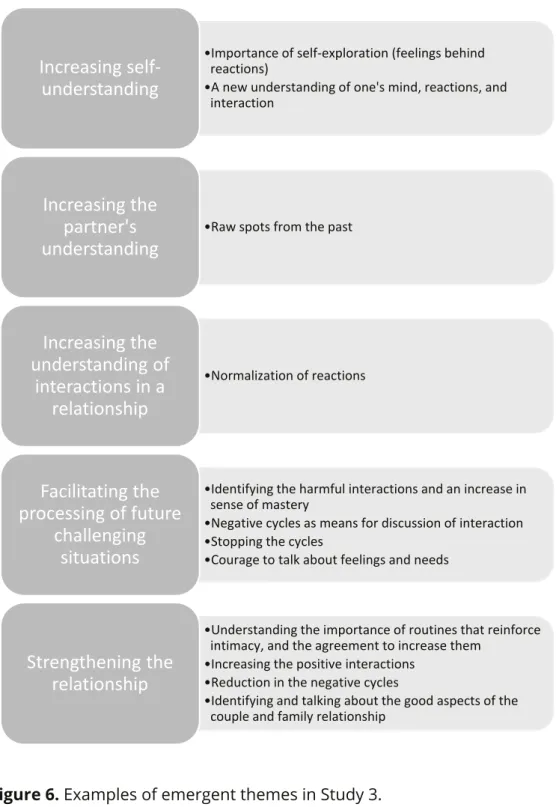After the course, the parents participated in a focus group discussion, which aimed to explore the experiences of the course and its effects on the parents' intimate relationships. Recognizing the psychological effects and advising parents to get the help they need will promote treatment of the child's illness and prevent subsequent mental health problems for sick children, their siblings and parents.
Serious illnesses of childhood in Finland
Childhood cancer
Intensive treatments can cause strong, immediate and long-lasting adverse effects for the child, as well as worries and fears for the parents (e.g. Van Schoors, de Paepe, et al., 2019). Cancer in babies and older children also burdens parents heavily due to the life-threatening nature and possibility of recurrence of these diseases (van Schoors, de Paepe, et al., 2019).
Birth asphyxia and congenital anomalies
Sometimes different combinations of chemotherapy, surgery and radiotherapy are used to ensure recovery (Jensen et al., 2021; Storm et al., 2019). Some congenital anomalies, such as esophageal atresia, gastroschisis, and omphalocele, require intensive treatment during the first days after birth and beyond (Gamba & Midrio, 2014; van der Zee et al., 2017).
Theoretical background of couple resilience and dyadic
Adult attachment theory
Bowlby described and conceptualized individual differences in attachment system functioning and emotion regulation based on the degree of responsiveness and protectiveness of attachment figures. This model focuses on the emotion-regulating function of the adult attachment system and explains individual differences in the functioning of this system.

Social baseline theory
Individuals with responsive social contacts expend less self-regulatory effort and personal resources when responding to threatening situations (Coan et al., 2013). One form of interpersonal emotion regulation is burden sharing, which means sharing emotional burdens associated with challenging situations in social relationships (Ehrenberg et al., 2001; Lougheed et al., 2016).
Dyadic emotion regulation
In this case, one partner's regulatory strategy may be an emotional trigger for the other partner that challenges the couple's dyadic emotion regulation. In couples, the regulation of positive emotions is at least as important as the regulation of negative emotions (Levenson et al., 2014).
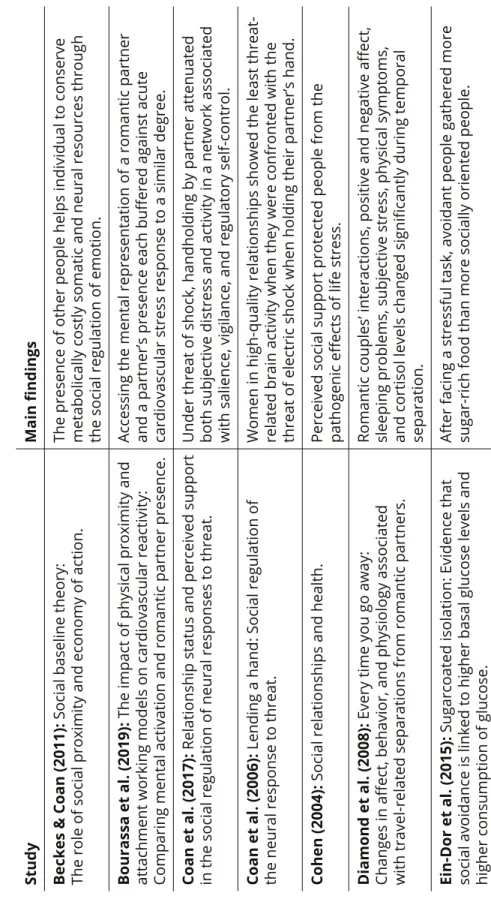
The effects of serious illness of a child on parents’ mental health
Psychiatric symptoms
On the other hand, posttraumatic avoidance symptoms may cause parents to avoid necessary medical visits and procedures (Stuber et al., 1996). Arousal symptoms may cause parents to overprotect their children and limit their participation in activities that interfere with their normal development (Hoge et al., 2021; Santacroce, 2002).
Life satisfaction, posttraumatic growth, and resilience
In mothers, predictors of PTG include seeking emotional support, religious coping and planning (Aftyka et al., 2020). Although no difference was found in comparing the life satisfaction of sick or healthy children (Blackwell et al., 2019).
Protective and risk factors
Life satisfaction can be defined as “a desired subjective feeling that indicates general well-being” (Koivumaa-Honkanen et al., 2000, p. 983). For example, a high-quality intimate relationship is associated with mental health in parents of children with cancer (Salvador et al., 2019).
The connections of a child’s serious illness to the parental
Impact of illness on the intimate relationship of parents
In addition, the diagnosis is experienced as an individual stressful phase and hospital admissions cause additional relationship stress (Wiener et al., 2017). In a qualitative study by Arruda-Colli et al. 2018), the factors influencing marital relationships are related to the relationship, illness experience and external factors.
Parents’ couple resilience
We-ness promotes a couple's ability to adapt and cope dyadically and facilitates the individual growth of the partners, offering a protective resource (Fergus, 2011; Singer & Skerrett, 2014; Skerrett, 1998). Several researchers have stated that the dyadic perspective and togetherness in relation to long-term illnesses reflects the couple's resilience and adaptability (Badr et al., 2010, Berg et al., 2008; Fergus, 2011; Skerrett, 1998).
Couple interventions for the parents of seriously ill children
Emotionally focused interventions
In the study, couples' distress decreased significantly after treatment and at a 5-month follow-up compared to the control group (Walker et al., 1996). According to the results, marital adjustment was higher in the treatment group than the control group both at post-treatment and follow-up.
Hold Me Tight program
According to a follow-up study by Cloutier et al. 2002), substantial improvements in relationships among parents of severely ill children receiving EFT were maintained at a 2-year follow-up, and some couples even showed further improvements at follow-up. For example, the HMT intervention improved relationship satisfaction and well-being in Huntington's disease patients and their partners (Petzke et al., 2022).
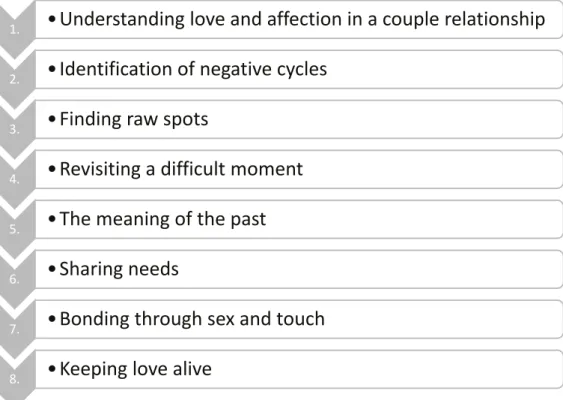
Study design and participants
The control group*** of Study 2 consisted of 30 heterosexual couples (60 participants, ages ranging from 20 to 47 years) who were parents of healthy children. The parents of sick children in studies 1 and 2 were recruited from the Child and Adolescent Center of Excellence at Kuopio University Hospital in the NICU and the Department of Pediatric Hematology and Oncology. I first interviewed the parents of Study 1 individually within three weeks of their child's diagnosis.
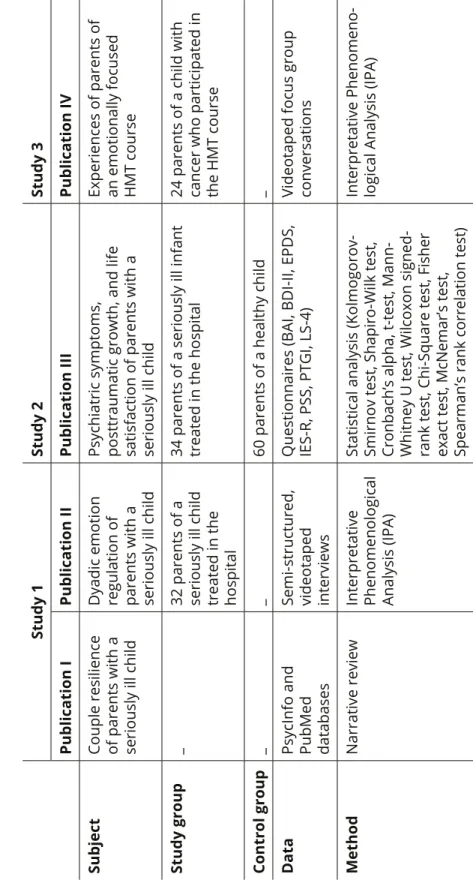
Interview procedures
Interview in Study 1
The purpose of the interview was to investigate the emotional experiences and psychological reactions of the parents. The interview began with questions from the parents about the situation related to the child's illness and hospitalization, and then moved on to explore more specific psychological and interpersonal issues. Participants were also encouraged to share their feelings during the interview to ensure that they were in a stable state of mind during and after the sensitive discussion.
Interview in Study 3
The interviews were conducted in a conversational style and the sensitivity of the subject was considered in the situation. The interview contained open-ended questions that guided the flow of the interview but allowed for a flexible discussion about specific issues raised by the participants. Parents were asked about, for example, the possible effects of the course on their relationship, the future and the parents' own ways of coping.
Analysis procedures
Interpretative Phenomenological Analysis (IPA)
- Stage 1: Transcribing, reading, and re-reading
- Stage 2: Preliminary notes
- Stage 3: Developing of emergent themes
- Stage 4: Searching for the connections between
- Stage 5: Review of the emergent themes and their
- Stage 6: Searching for patterns through the cases
Looking for patterns through the cases. the videotapes to recall the situation and emotional content of the data. On second reading, I added linguistic comments to the file focusing on the language of the interview. According to Smith et al. 2012), measuring the frequencies across the cases is appropriate, especially with large sample sizes.
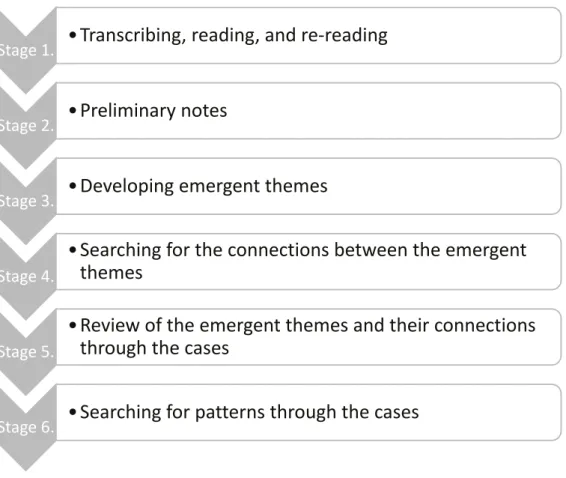
Quantitative measures
- Anxiety (BAI)
- Depressive symptoms (BDI-II, EPDS)
- General stress (PSS)
- Posttraumatic growth (PTGI)
- Posttraumatic symptoms (IES-R)
- Life satisfaction (LS-4)
The Beck Anxiety Inventory (Beck et al., 1988) was used to assess participants' subjective anxiety. The Perceived Stress Scale (Cohen et al., 1983) was used to assess subjective experiences of psychological stress. The Inventory of Posttraumatic Growth (Tedeschi & Calhoun, 1996) was used to assess positive changes due to a crisis.
Statistical methods
The PTGI score was dichotomized into no significant positive change (PTGI score 0–41) and at least a small positive change (PTGI score 42–105) (Sawyer et al., 2012). The Impact of the Event Scale-Revised questionnaire (Weiss & Marmar, 1997) was used to assess the subjective distress caused by the traumatic event. The Life Satisfaction Scale – 4 (Allardt, 1973; Koivumaa-Honkanen et al., 2000) was used to assess participants' subjective interest and happiness in life, ease of life, and loneliness.
Ethical approval
Couple resilience, dyadic emotion regulation and its importance
- Recognition and disclosure of the needs of dyadic
- Load sharing and dyadic regulation of emotions
- Importance of dyadic emotion regulation in terms of
- Challenges of dyadic emotion regulation
Two ad ic e m ot io n r reg ula tio n Recognition and discovery of dyadic emotion regulation needs (4/7). Non-verbal interaction, presence and intimacy (8/9) Verbal interaction (13/11) The importance of dyadic emotion regulation for one's coping (5/7). Being with the other person and living, experiencing, and sharing the situation together were considered essential forms of dyadic emotion regulation.
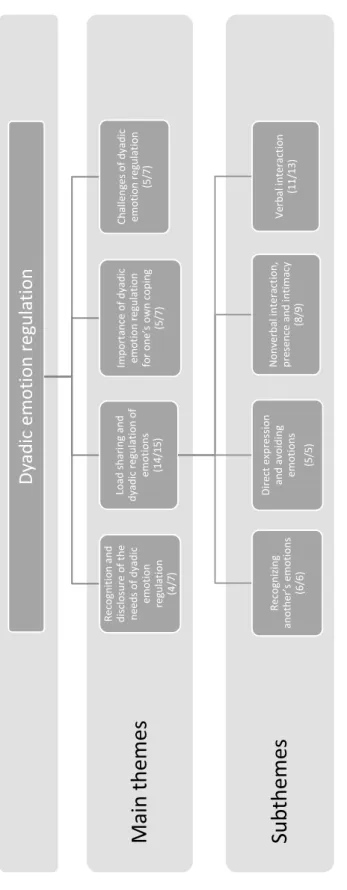
Psychiatric symptoms, posttraumatic growth, and life satisfaction
- Anxiety
- Depressive symptoms
- General stress
- Posttraumatic growth
- Posttraumatic symptoms
- Life satisfaction
- Individual-related meanings
- Couple-related meanings
- Family-related meanings
Shortly after the birth of the child (baseline), anxiety (BAI score ≥16/63) was more common in parents with a sick child than in the control group (p = 0.032). At baseline, depressive symptoms (BDI-II score ≥14/63) were more common in parents of a sick infant than in the control group (p = 0.003). Mothers found the course helped them identify and discuss the strengths of the family.
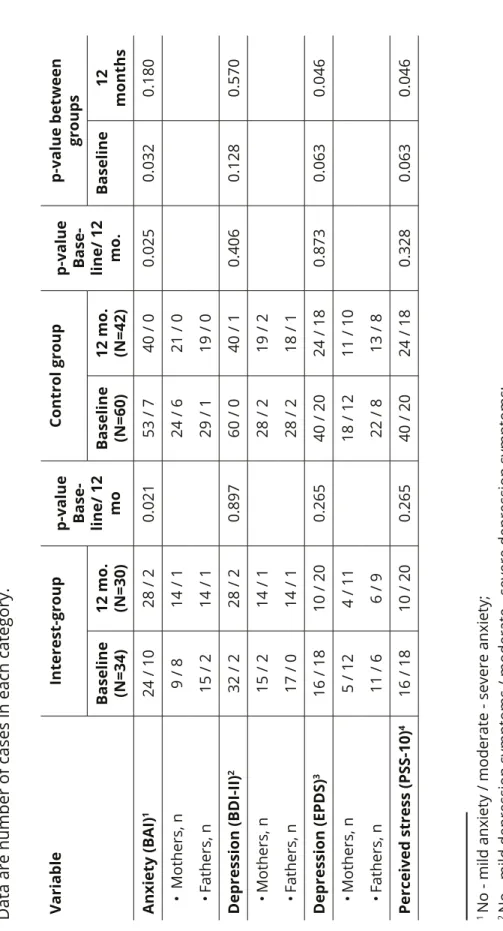
Individual and couple resilience of parents
Couple resilience and dyadic emotion regulation of
Gordon et al., 2012; Levenson et al., 2014; Waugh, 2014) have identified the importance of positive emotions in terms of dyadic resilience, especially in stressful life situations. According to Horn et al. 2018), humor serves as a dyadic emotion regulation strategy in couples' daily lives. According to Hooghe et al. 2017, p. 226), "the process of speaking and not speaking can be partially understood as an emotionally responsive process on an interpersonal and intrapersonal level.
Mental health among parents with seriously ill and
According to Aftyka et al. 2020), PTG among fathers was predicted by seeking emotional support and positive reinterpretation of the stressful situation. The parental prediction of the future quality of life was not related to the child's disability risk. The stress of the hospital situation itself did not reduce parental resilience and three quarters of the parents had good resilience (Ferrand et al., 2018).
Emotionally focused interventions in supporting parents
This may be related to their resilience and is consistent with previous studies (e.g. Isokääntä et al., 2019; Picoraro et al. found that parental resilience was a key factor related to a good quality of life after the NICU, and parents with lower resilience were more pessimistic about their infant's recovery. The HMT program was found to produce positive changes in relationship satisfaction, trust, attachment security and family functioning, and to reduce marital distress and depression (Conradi et al., 2017; According to Cloutier et al. 2002), EFT increases the experience of comfort and support and protects parents from stressful situations by strengthening emotional bonding and commitment.
Strengths and limitations
On the other hand, the knowledge of the parents and the subject may have damaged my objectivity and the reliability of the research. On the other hand, the breadth of research data can also limit the depth of analysis. On the other hand, the homogeneity of the sample can support the deep, detailed and rich expression of experience.
Clinical implications and suggestions for future research
In this study, the child's illness was a unifying experience for all participants, and those involved in the focus groups had the common experience of the HMT course. Also, careful consideration of the timing and content of these difficult topics would be important in the future when working with parents who are overwhelmed by their child's illness. Understanding and supporting the parent's relationship can contribute to the child's recovery and the well-being of the entire family.
Conclusions
Is post-traumatic growth possible in parents of former neonatal intensive care unit patients? Prevalence and correlates of posttraumatic stress and postpartum depression in parents of infants in the Neonatal Intensive Care Unit (NICU). In our research, half of the parents of critically ill infants reported PTG in the PTGI.
Is post-traumatic growth possible in the parents of former neonatal intensive care unit patients. Prevalence and correlates of posttraumatic stress and postpartum depression in parents of infants in the neonatal intensive care unit (NICU).

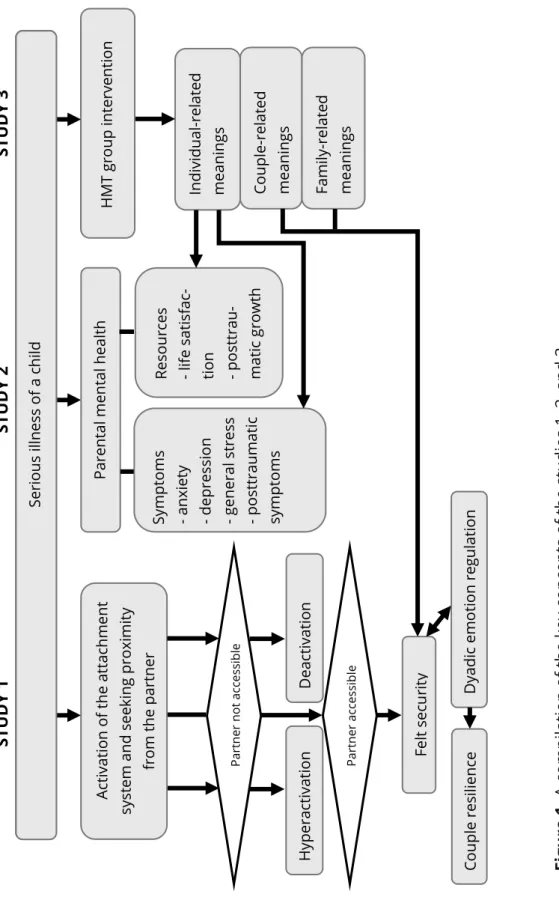
![Table 3. Characteristics of participants in studies 1, 2, and 3. VariableStudy 1Study 2Study 3 Interview group* (N=32)Exposed group** (N=34) Control group*** (N=60)Focus groups**** (N=24) Age (yrs) Fathers n=16 35 [21-55] 34.7 (9.5)](https://thumb-eu.123doks.com/thumbv2/9pdfco/1891141.267307/62.748.89.649.62.975/characteristics-participants-studies-variablestudy-interview-exposed-control-fathers.webp)
